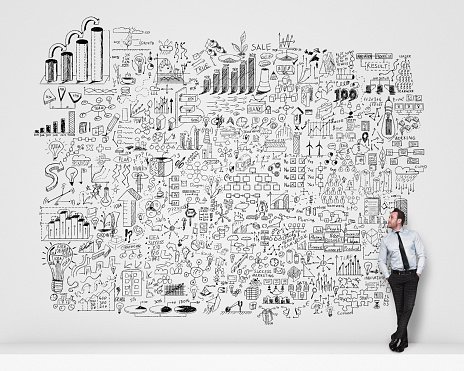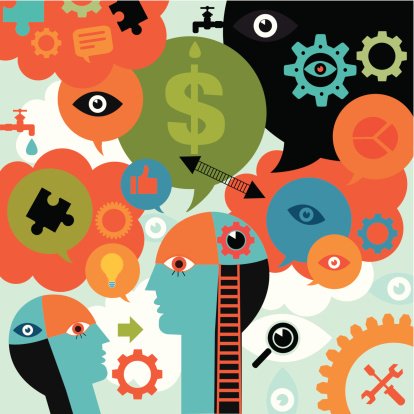
Right now, before even getting into the true meat of this article— the cream de la crème— your eyes have already darted thousands of times towards the images, unconsciously running a full once-over. Why? Because the brain processes visuals faster than any other type of content—identifying images in just 13 milliseconds. In fact, 90% of the information sent to the brain, is visual; and by 2018, it is predicted that as much as 84% of marketing communication will be visual—talk about needing to nail the first impression! Perhaps, we need to reevaluate the old strategy, “content is king” and swap it to “visuals are king.”
What does this mean for your business and marketing strategy? Picture it. As the saying goes, a photo is worth a thousand words, so save yourself some verbiage and add a little visual—in your emails, on your website, even on your social media handles. Here’s why:
First Impressions are Everything.
A study done by the Stanford Persuasive Technology lab noted that 46.1% of visitors discerned a company’s credibility straight from its website design. If you’re not greeting potential clients dressed up with visuals and looking the part, you could be potentially losing half of your business and never get the chance to wine and dine them—if you know what we mean.
We are a Generation of A.D.D.-ers.
A recent study showed that human attention span has dropped down to a mere eight seconds… (yes, likely less than the time it took you to read this), that’s shorter than that of a goldfish. If that’s not bad enough, our brains are (over) stimulated— receiving five times as much information on a daily basis than we did 30 years ago. What does this mean for marketing and communication? We need to capture audience attention and do it fast. Content with visuals gets 94% more views than that without, so do yourself—and your audience— a favor and break up that encyclopedic-like block of text with some eye candy.

Increased Engagement.
Social media is another outlet that has completely changed the way that companies interact in a direct-to-consumer capacity—so don’t miss the opportunity to increase engagement by integrating visuals for the eyes to easily digest. Tweets get retweeted 150% more with photos than without and a recent study by Adobe discovered that Facebook posts with images see a whopping 650% higher interaction than those without.
Try a (Visual) Call to Action.
Try serving up some imagery dishes to give your audience a brain boost. People are able to follow illustrated directions 323% better than direction without visuals. They also recall 80% of what they see and do, compared to a mere 20% of what they read. Trying to integrate a CTA (Call-to-Action) or inform your audience about a sale or important up-and-coming event? Mix in a photo or illustration the next time.
The Future is Visual.
As technology and social media have continued to evolve, video has emerged as a key player in the future of communications. In 2015, on a daily basis, users were averaging almost 11% more time spent with digital video than on social networks. Video will likely play the most prominent and substantial role in direct-to-consumer visual communication. Today, four times as many consumers prefer watching a product video to reading about it; but perhaps, this should come as no surprise as we can gather the sense of a visual scene in less than 1/10 of a second. Lazy or time-saving? You decide.
Where can you include visuals in your communications with consumers?
- Email marketing/email campaigns
- Websites
- Company blog posts
- Social media
- Fliers and brochures
Some examples of visual content are:
- Images
- Videos
- GIFS, memes
- Infographics
Still not convinced? Here’s one last tidbit for you—if this article had not included any visuals, you’d be likely to remember only 10% of the information three days later. Not to worry, since we integrated some beautiful aides, you’re likely to retain at least 65% of this. Guess it goes to combat the old saying— sometimes looks are everything!
We know— you’re welcome. Now get to work!
Sources:
BRAIN RULE RUNDOWN Rule #10: Vision trumps all other senses. (n.d.). Retrieved from http://www.brainrules.net/vision
Cooper, B. B. (2013, November 13). How Twitter’s Expanded Images Increase Clicks, Retweets and Favorites [New Data]. Retrieved from https://blog.bufferapp.com/the-power-of-twitters-new-expanded-images-and-how-to-make-the-most-of-it
Effects of text illustrations: A review of research. (n.d.). Retrieved from https://link.springer.com/article/10.1007%2FBF02765184
M., O’Neill. (2015, May 7). The 2015 Video Marketing Cheat Sheet [Infographic]. Retrieved from https://animoto.com/blog/business/video-marketing-cheat-sheet-infographic/
N. (n.d.). 13 Reasons Why Your Brain Craves Infographics. Retrieved from http://neomam.com/interactive/13reasons/
Pinantoan, A. (2015, May 20). How To Massively Boost Your Blog Traffic With These 5 Awesome Image Stats. Retrieved from http://buzzsumo.com/blog/how-to-massively-boost-your-blog-traffic-with-these-5-awesome-image-stats/
Shrivastava, S. (n.d.). The Power Of Visual Content In Your Content Marketing Strategy. Retrieved from https://blog.rankwatch.com/the-power-of-visual-content-in-your-content-marketing-strategy/
Watson, L. (2015, May 15). Humans have shorter attention span than goldfish, thanks to smartphones. Retrieved from http://www.telegraph.co.uk/science/2016/03/12/humans-have-shorter-attention-span-than-goldfish-thanks-to-smart/
Trafton, A. (2014, January 16). In the blink of an eye. Retrieved from http://news.mit.edu/2014/in-the-blink-of-an-eye-0116


 We’re blogging, we’re info-graphing, we’re creating listicles, and gifs, and videos, and images. We need content for our emails, our website, our Snapchat, our Instagram, our Tumblr. New channels for marketing your brand seem to pop-up every day. And in our efforts to help our brand stand out above the rest,
We’re blogging, we’re info-graphing, we’re creating listicles, and gifs, and videos, and images. We need content for our emails, our website, our Snapchat, our Instagram, our Tumblr. New channels for marketing your brand seem to pop-up every day. And in our efforts to help our brand stand out above the rest,